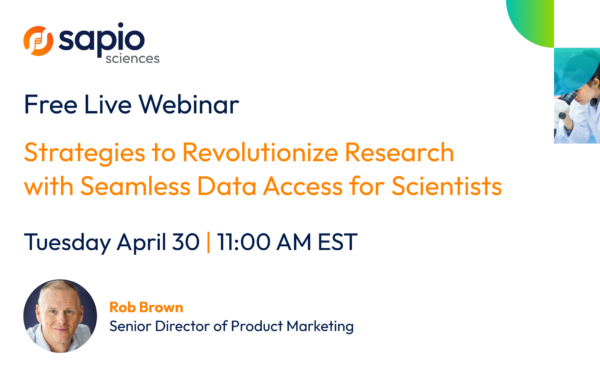For most scientists working in a core facility, taking time to collect, process, prepare, and analyze instrument data is ‘just part of the job.’ Despite significant advances in laboratory informatics and automation technologies, many data acquisition workflows remain predominantly manual. And yet, they are not necessarily broken. Laboratories have long been relying on these ‘tried and true’ methods to conduct their daily work. While these approaches are functional, they are still not optimal.
Fortunately, a new approach is emerging—one that prioritizes automation, eliminates manual effort, and most importantly, places rich, contextualized data in the hands of the scientist.
In this blog, we’ll examine the traditional method for data analysis and collection used by most large-scale core facilities. Then, we’ll surface key opportunities for optimization, enabled by a science-aware™ approach. Finally, we’ll quantify some of the savings organizations can anticipate by transforming their lab data collection and analysis workflows.
The manual approach to data collection and analysis
Let’s start by examining the manual way, which remains the prevailing approach to scientific data collection and processing—even in some of the industry’s largest pharmaceutical organizations. While the industry widely accepts this method as the de facto standard, it falls short in a variety of ways, including:
- Manual data handling: Manual data collection not only claims a significant amount of the scientist’s time, but it also comes with a margin of error and latency.
- Disconnected systems: Most labs have specialized software in place to run analyses on their data, but to use them, they must manually load data into the solution after collection—representing more time and effort.
- Report generation: Report generation is another critical part of the scientist’s workflow, but a largely manual approach significantly delays the timeliness and seamlessness of this effort.
What does an inefficient core facility look like?
Let’s examine these inefficiencies in action with a hypothetical scenario. A molecular biologist is working in the core facility of a Fortune 1000 pharmaceutical organization. She is responsible for identifying genetic markers linked to cancer, requiring extensive DNA sequencing with short- and long-read sequencing technologies.
After preparing samples and loading them onto sequencing platforms, the molecular biologist manually collects data from the various instruments used in her experimentation, including next-generation sequencers and bioanalysis instruments for quality control. She then enters these figures into an Excel spreadsheet on her workstation. In total, this effort consumes up to 16 hours of her week.
After data collection is complete, the molecular biologist and her team spend additional time on data normalization, collating data from different runs and ensuring consistency across data formats. This step in the process is a critical prerequisite to accurate analysis and comparison of genomic sequences.
Once collated, the molecular biologist manually loads the data into her lab’s analytics software, making sure that everything is formatted correctly and that no errors are present. After this step is complete, she manually compiles key takeaways into reports. Collectively, the scientist spends more time on data management than she does on the core activities of sample preparation and sequencing. In this hypothetical scenario, the molecular biologist and her five team members collectively spend up to 168 hours of a typical workweek on data processing and management.
The science-aware™ approach to scientific data unification and analysis
To accelerate lab workflows and achieve new levels of scientific insight, modern life sciences labs require a data platform that has been specifically built for the demands of scientists. By adopting a solution that automates data collection, unifies data, and supports granular analysis all in a single platform, organizations can virtually eliminate manual data collection workflows and enable scientists to spend more time advancing their research. Here are some of the advantages this type of solution can deliver:
- Automated data management: Automating the entire data management process prepares data for analysis instantly and with minimal burden on the scientist while also reducing the opportunity for error.
- Integrated systems and tools: With collection, processing, and analysis in one, centralized solution, there is no need for time consuming manual imports and exports.
- Streamlined reporting: Fully integrated analysis and report generation empower scientists to streamline and standardize reports while maintaining the ability to configure them to unique research requirements.
Let’s revisit our molecular biologist and see how her daily workflow changes with a science-aware™ platform for her organization’s scientific data.
The molecular biologist prepares her DNA samples and loads them onto sequencing platforms as usual. Because the data is automatically collected and unified across instruments, she can go straight to analysis. The molecular biologist no longer needs to import and export her organization’s data, nor does she need to spend time sorting through errors. Instead, she is free to run rich genomic analyses in a single platform. At the simple click of a button, she can transform her analyses into meaningful reports and summarize key takeaways before moving on to her next project or process.
Quantifying the value of a science-aware™ solution
By adopting a unified, science-aware™ platform for data unification and analysis, the molecular biologist, her team, and her organization can unlock transformative efficiency and productivity gains. Let’s quantify some of these.
Recall that the molecular biologist in our scenario was spending 28 hours of a typical week on data collation, analysis, and reporting. With the new platform, she no longer spends any time on collecting data, and her time spent on analysis and reporting is significantly reduced. The new platform reduces her weekly time spent on data-related tasks from 28 hours to just six.
If her time spent on sequencing remains the same, the molecular biologist and her team’s turnaround time will more than double. For example, a team of six can go from managing five requests each week to comfortably managing ten with the same number of team members.
In addition to quantifiable time savings, the potential for error associated with manual data entry is virtually eliminated. In addition, the platform enables scientists to catch inconsistent results that could indicate instrument malfunction proactively—minimizing downstream delays. All of this enables greater productivity, more accurate results, richer scientific analyses, and accelerated research.
While this blog uses a DNA sequencing example from a core facility, the problem of manual data collection and analysis crosses diverse scientific disciplines, including protein preparation, synthetic biology and chemical screening, in vivo and in vitro studies, and more.
Accelerate data collection and analysis with Sapio Jarvis
Most of today’s approaches to implementing a scientific data management system focus on optimizing one part of the scientific data workflow, such as bringing the data together or supporting analysis and visualization. These solutions, however, stop short of solving the problem. A real solution to the challenge must address data unification, searchability, analysis, and reporting all in one, and in a way that prioritizes the scientist above all.
The first science-aware™ data platform of its kind, Sapio Jarvis addresses all of these requirements in a single platform made for the scientist. With Jarvis, scientists can spend far less time on data management, and far more time advancing their critical research.
If you’re interested in learning more about the assumptions behind this blog post or would like to see a demo of Jarvis, contact Sapio today.





